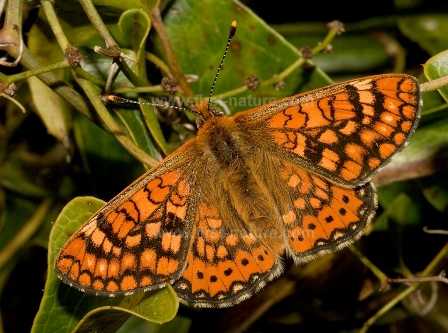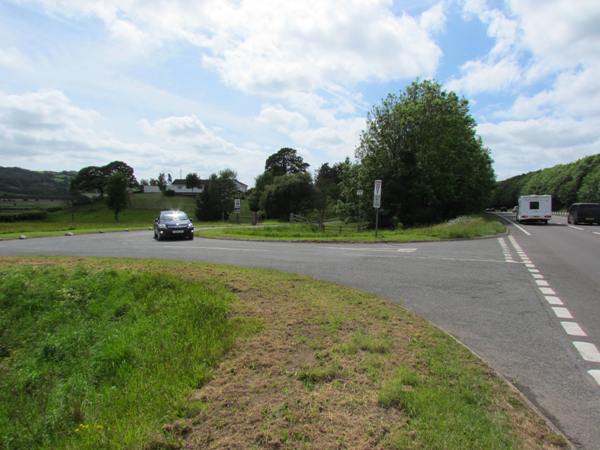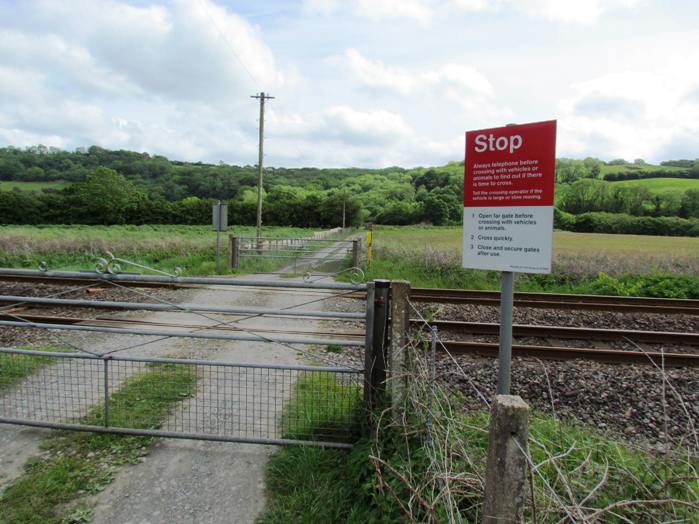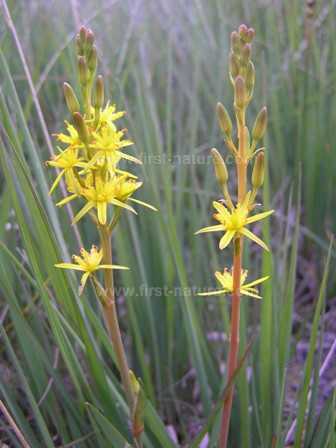Cors Goch Llanllwch National Nature Reserve, Nr. Carmarthen, Southwest Wales
Designations: SSSI
Below: The Marsh Fritillary - picture Rob Petley-Jones

Cors Goch Llanllwch NNR is one of the remaining large raised bog areas in Wales, but it comes with a Health Warning! This type of habitat is so rare and special that its protection and preservation is vital for the wildlife species that depend upon such places for their survival, and it is our general view that what is funded by the tax payer should be available for the tax payer to visit and enjoy. There is, however, an exception to every rule and Cors Goch Llanllwch NNR is, we think, one such: if you want to see a raised bog go to Borth Bog (Cors Fochno) at Dyfi NNR or to Tregaron Bog (Cors Caron), both of which are within a reasonable distance of Carmarthen and have excellent facilities for visitors.
As we approached Cors Goch Llanllwch via one of the only two access routes our train of thought about visiting the reserve was interrupted - by a train charging along the mainline Pembrokeshire to London route that passes slap bang through the middle of this reserve! The alternative entry point to the eastern end of the reserve is also fraught with difficulty, being at the western end of Carmarthen Showground.
Below: The left hand turn towards the Reserve from the main A40 from Carmarthen to St. Clears.

Entry to the Showground when there is an event being held there might be a safe bet, but when it is not being used for a show the access is through one partially opened gate which is adorned with signs promising multiple penalties should you enter this private land without permission. And what would happen if you failed to return to your car before the staff left for the day? Would the gates be locked resulting in you being marooned in the confines of the showground overnight? All of this, coupled with a deeply rutted track down to and beyond the railway line and no guarantee of being able to park near the reserve entrance having risked life and limb to get there, caused us to rethink our visit and relegate Cors Goch Llanllwch to the bottom of our list of nature reserves yet to be visited.
The site is owned and managed by the Wildlife Trust of South and West Wales.
Directions
Grid Ref: SN361185
Western end of the Reserve: From Carmarthen take the main A40 road west towards St. Clears and continue past Carmarthen Showground.
Below: The main railway line that passes through the Reserve

Take the next turning left signed towards Sarnau Mansions B&B; turn right towards the guesthouse and continue down this lane (which becomes a gravel track) down to Lan y Gors Farm.
Continue through the farmyard and down a deeply rutted mud track to the double gates on either side of the mainline railway track.
If you decide to proceed, do so with great care and attention, and be sure to close both gates behind you as the penalty for not doing so is a fine of £1,000 if you are caught.
Once over the track continue down to Cwm Coch Farm, where you may be able to park with the owner's permission, and then walk to the reserve.
Eastern end of the Reserve: Access is possible from Carmarthen Showground, which is on the main A40 road from Carmarthen to St. Clears some 5km (3.5 miles) from Carmarthen town centre.
If the showground is not holding an event, you must report to the staff in Reception to obtain permission before parking your car there.
Access
There is a track through part of the reserve and, given the nature of the bog, it is advisable to stay on it at all times.
The reserve is not suitable for wheelchair users or for people with prams or pushchairs.
Facilities
There are no facilites at this nature reserve.
Description of Site
Cors Goch Llanllwch began its development into the dome of raised bog that we see today as a lake formed after the last Ice Age, approximately 12,000 years ago. The lake bed consisted of clay, sand and gravel, and over time the remains of aquatic plants that grew in the lake built up to form a thick layer of peat - up to 5m deep in some parts of the bog. The groundwater stored in this type of lowland raised mire comes solely from precipitation, and if uninterrupted the formation of the peat can result in a dome several metres higher than the level of the groundwater beneath it.
Scientific examination of this peat could provide a paleoenvironmental record (such as pollen records) stretching back some 8,000 years; any damage or extraction of the peat causing it to dry out would result in the loss of this unique historical evidence of Carmarthen's plantlife.
Below: The bright yellow starry flowers of Bog Asphodel

Today the reserve is home to some of the special plants and creatures that depend on this rare type of habitat for their survival. Typical plants of this environment that are present at Cors Goch Llanllwch include the lovely Marsh Cinquefoil (Comosum palustre), Bog Myrtle (Myrica gale), Bog Asphodel (Narthecium ossifragum), Narrow Buckler Fern (Dryopteris carthusiana) and White Beak Sedge. Here you will also find both Round-leaved (Drosera rotundifolia) and Oblong-leaved Sundew (Drosera intermedia), carnivorous plants that feed on the myriads of small insects which, in turn, try to feed on us when we visit such places! The splendid Royal Fern (Osmunda regalis) also grows in the bog, and there are some fine areas of Purple Moor Grass (Molinia caerulea) in the southern and western parts of the site.
Another very special and rare inhabitant of the bog is the Black Bog Ant (Formica candida), which is recorded from only one other place in Wales - Rhossili Down SSI in the Gower. This ant makes its small conical-shaped nest from Sphagnum Moss and grasses, including Purple Moor Grass. Each nest, which seems to survive occasional submersion, typically contains one queen and up to 1,000 workers. The Black Bog Ant is an endangered species in the UK, where it is threatened by the loss of its habitat due to drainage of wetlands for agricultural purposes or urban development, but it could equally suffer as a result of prolonged drought.
The rare Small Red Damselfly (Ceriagrion tenellum) and the Black Darter Dragonfly (Sympetrum danae) are present on the reserve, as are also Bush Crickets and the Marsh Fritillary Butterfly (Euphydryas aurinia).
Lowland Raised Mires such as Cors Goch Llanllwch attract many bird species, and typical among them are Common Teal (Anas crecca), Curlew (Numenius arquata) and Water Rails (Rallus aquaticus).
This nature reserve protects an increasingly rare and important range of habitats; but, due to the access difficulties and the terrain, if your interest is general rather than specific then we think it would be better to visit some of the other similar nature reserves in Wales that have excellent visitor access and facilities for easier observation and enjoyment of the special plants, birds and other creatures that live in such places.